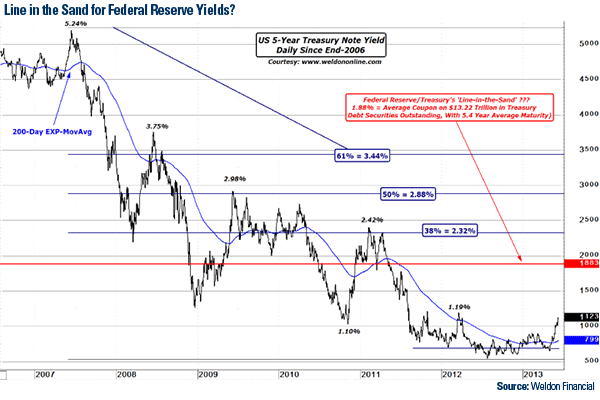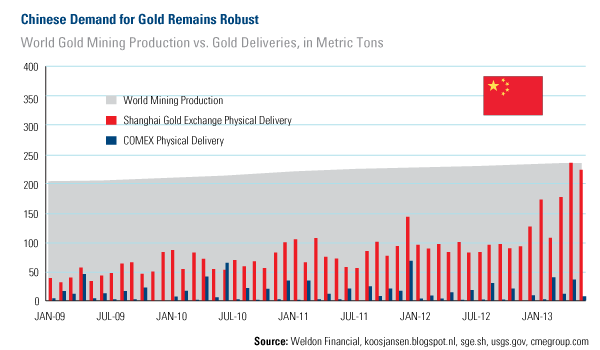I recently discussed how traders were stampeding out of gold as a result of rising interest rates and the threat of evaporating monetary fluid that was lubricating markets. Hovering around $1,200 at the beginning of July, the gold price has completely disconnected from the precious metal’s fundamentals, in my opinion. Prices have fallen too far out of fear, but the drivers for gold are still in place.
My friend and highly respected analyst, Gregory Weldon, highlighted an important point about rising rates in the U.S. The coupon on the nation’s $13.22 trillion debt averages 1.88 percent with an average maturity of 5.4 years. As interest rates rise, debt will be rolled over at a higher rate, making the burden even greater than it already is. This suggests a likely tipping point for Treasuries. Will the Federal Reserve suppress yields at that “line in the sand?”
In this environment, gold should remain attractive. However, as the West flees the precious metal, another set of gold buyers has come forward with the aim to preserve wealth. Take a look at the chart below which shows total gold production compared to the gold deliveries on the COMEX and the Shanghai Gold Exchange. In May, gold imports into the Asian giant rose to the second-highest level ever. While mining production is around 1,134 tons so far this year, gold delivery on the Shanghai Gold Exchange is 918 tons. This is strikingly in contrast to the gold delivery on the COMEX, which stands at only 103 tons year-to-date as of the end of May.
In fact, this year’s demand is so significant that the physical gold delivered on the Shanghai Gold Exchange through May is almost all of the official gold reserves in China! As George Topping of Stifel Nicolaus puts it, “Annualizing 2013 year-to-date figures, China’s imports would be equivalent to 50 percent of [world] mine production.”
China may be devouring even more of the supply in the future if the price of gold remains subdued. I’ve been talking with several gold company executives, who tell me they are seeing squeezed margins because of lower grade finds, as well as governments raising taxes or increasing royalty rates.
The top priority for these miners today is cost control, focusing their efforts on viable projects that have all-in costs of less than $1,000 per ounce of gold. If spending is too expensive, exploration is cut and production is halted.
This is an extremely conservative amount, as some gold mining projects in certain countries come in significantly higher. The CEO of Gold Fields recently indicated that the average all-in cost in Africa is $1,500!
This is a similar phenomenon to the supply of natural gas recently. When there were huge discoveries in the commodity, companies immediately halted drilling. There’s a notable difference in drilling gas versus mining gold, though: The natural gas cycle is shorter and measured in months, so there can be a relatively quick recovery in supply. When gold companies cut production, the restart cycle can take decades.
To me, these supply and demand drivers point to a sustained higher gold price.
Disclaimer: All opinions expressed and data provided are subject to change without notice. Some of these opinions may not be appropriate to every investor.
Disclosure: The following security mentioned was held by one or more of U.S. Global Investors Funds as of 3/31/13: Gold Fields.
- English (UK)
- English (India)
- English (Canada)
- English (Australia)
- English (South Africa)
- English (Philippines)
- English (Nigeria)
- Deutsch
- Español (España)
- Español (México)
- Français
- Italiano
- Nederlands
- Português (Portugal)
- Polski
- Português (Brasil)
- Русский
- Türkçe
- العربية
- Ελληνικά
- Svenska
- Suomi
- עברית
- 日本語
- 한국어
- 简体中文
- 繁體中文
- Bahasa Indonesia
- Bahasa Melayu
- ไทย
- Tiếng Việt
- हिंदी
The Asian Giant Stampeding Into Gold
Published 07/08/2013, 02:56 PM
Updated 07/09/2023, 06:31 AM
The Asian Giant Stampeding Into Gold
Latest comments
Loading next article…
Install Our App
Risk Disclosure: Trading in financial instruments and/or cryptocurrencies involves high risks including the risk of losing some, or all, of your investment amount, and may not be suitable for all investors. Prices of cryptocurrencies are extremely volatile and may be affected by external factors such as financial, regulatory or political events. Trading on margin increases the financial risks.
Before deciding to trade in financial instrument or cryptocurrencies you should be fully informed of the risks and costs associated with trading the financial markets, carefully consider your investment objectives, level of experience, and risk appetite, and seek professional advice where needed.
Fusion Media would like to remind you that the data contained in this website is not necessarily real-time nor accurate. The data and prices on the website are not necessarily provided by any market or exchange, but may be provided by market makers, and so prices may not be accurate and may differ from the actual price at any given market, meaning prices are indicative and not appropriate for trading purposes. Fusion Media and any provider of the data contained in this website will not accept liability for any loss or damage as a result of your trading, or your reliance on the information contained within this website.
It is prohibited to use, store, reproduce, display, modify, transmit or distribute the data contained in this website without the explicit prior written permission of Fusion Media and/or the data provider. All intellectual property rights are reserved by the providers and/or the exchange providing the data contained in this website.
Fusion Media may be compensated by the advertisers that appear on the website, based on your interaction with the advertisements or advertisers.
Before deciding to trade in financial instrument or cryptocurrencies you should be fully informed of the risks and costs associated with trading the financial markets, carefully consider your investment objectives, level of experience, and risk appetite, and seek professional advice where needed.
Fusion Media would like to remind you that the data contained in this website is not necessarily real-time nor accurate. The data and prices on the website are not necessarily provided by any market or exchange, but may be provided by market makers, and so prices may not be accurate and may differ from the actual price at any given market, meaning prices are indicative and not appropriate for trading purposes. Fusion Media and any provider of the data contained in this website will not accept liability for any loss or damage as a result of your trading, or your reliance on the information contained within this website.
It is prohibited to use, store, reproduce, display, modify, transmit or distribute the data contained in this website without the explicit prior written permission of Fusion Media and/or the data provider. All intellectual property rights are reserved by the providers and/or the exchange providing the data contained in this website.
Fusion Media may be compensated by the advertisers that appear on the website, based on your interaction with the advertisements or advertisers.
© 2007-2024 - Fusion Media Limited. All Rights Reserved.
